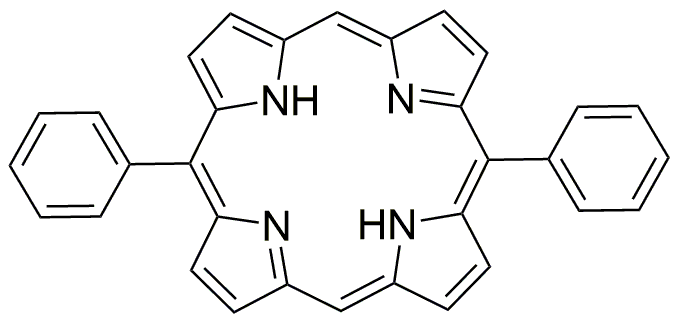5,15-Diphenylporphyrin is widely utilized in research focused on:
- Solar Energy Conversion: This compound is used in the development of dye-sensitized solar cells, enhancing their efficiency by improving light absorption and energy conversion.
- Photodynamic Therapy: In the medical field, it serves as a photosensitizer in cancer treatment, where it helps to selectively destroy cancer cells when exposed to light.
- Catalysis: It acts as a catalyst in various chemical reactions, particularly in organic synthesis, offering a more efficient pathway compared to traditional methods.
- Fluorescent Probes: The compound is employed in creating fluorescent probes for biological imaging, allowing researchers to visualize cellular processes in real-time.
- Material Science: It is used in the synthesis of advanced materials, such as organic semiconductors, which are crucial for developing flexible electronic devices.
Informations générales
Propriétés
Sécurité et réglementation
Applications
5,15-Diphenylporphyrin is widely utilized in research focused on:
- Solar Energy Conversion: This compound is used in the development of dye-sensitized solar cells, enhancing their efficiency by improving light absorption and energy conversion.
- Photodynamic Therapy: In the medical field, it serves as a photosensitizer in cancer treatment, where it helps to selectively destroy cancer cells when exposed to light.
- Catalysis: It acts as a catalyst in various chemical reactions, particularly in organic synthesis, offering a more efficient pathway compared to traditional methods.
- Fluorescent Probes: The compound is employed in creating fluorescent probes for biological imaging, allowing researchers to visualize cellular processes in real-time.
- Material Science: It is used in the synthesis of advanced materials, such as organic semiconductors, which are crucial for developing flexible electronic devices.
Documents
Fiches de données de sécurité (FDS)
La FDS fournit des informations de sécurité complètes sur la manipulation, le stockage et l’élimination du produit.
Spécifications du produit (PS)
Le PS fournit une description complète des propriétés du produit, notamment sa composition chimique, son état physique, sa pureté et les exigences de stockage. Il détaille également les plages de qualité acceptables et les applications prévues du produit.
Certificats d'analyse (COA)
Recherchez des certificats d'analyse (COA) en saisissant le numéro de lot du produit. Les numéros de lot et de lot se trouvent sur l'étiquette d'un produit, après les mots « Lot » ou « Lot de fabrication ».
Numéro de catalogue
Numéro de lot/série
Certificats d'origine (COO)
Ce certificat d'exploitation confirme le pays dans lequel le produit a été fabriqué, et détaille également les matériaux et composants utilisés et s'il est issu de sources naturelles, synthétiques ou autres sources spécifiques. Ce certificat peut être requis pour les douanes, le commerce et la conformité réglementaire.
Numéro de catalogue
Numéro de lot/série
Fiches de données de sécurité (FDS)
La FDS fournit des informations de sécurité complètes sur la manipulation, le stockage et l’élimination du produit.
DownloadSpécifications du produit (PS)
Le PS fournit une description complète des propriétés du produit, notamment sa composition chimique, son état physique, sa pureté et les exigences de stockage. Il détaille également les plages de qualité acceptables et les applications prévues du produit.
DownloadCertificats d'analyse (COA)
Recherchez des certificats d'analyse (COA) en saisissant le numéro de lot du produit. Les numéros de lot et de lot se trouvent sur l'étiquette d'un produit, après les mots « Lot » ou « Lot de fabrication ».
Numéro de catalogue
Numéro de lot/série
Certificats d'origine (COO)
Ce certificat d'exploitation confirme le pays dans lequel le produit a été fabriqué, et détaille également les matériaux et composants utilisés et s'il est issu de sources naturelles, synthétiques ou autres sources spécifiques. Ce certificat peut être requis pour les douanes, le commerce et la conformité réglementaire.


